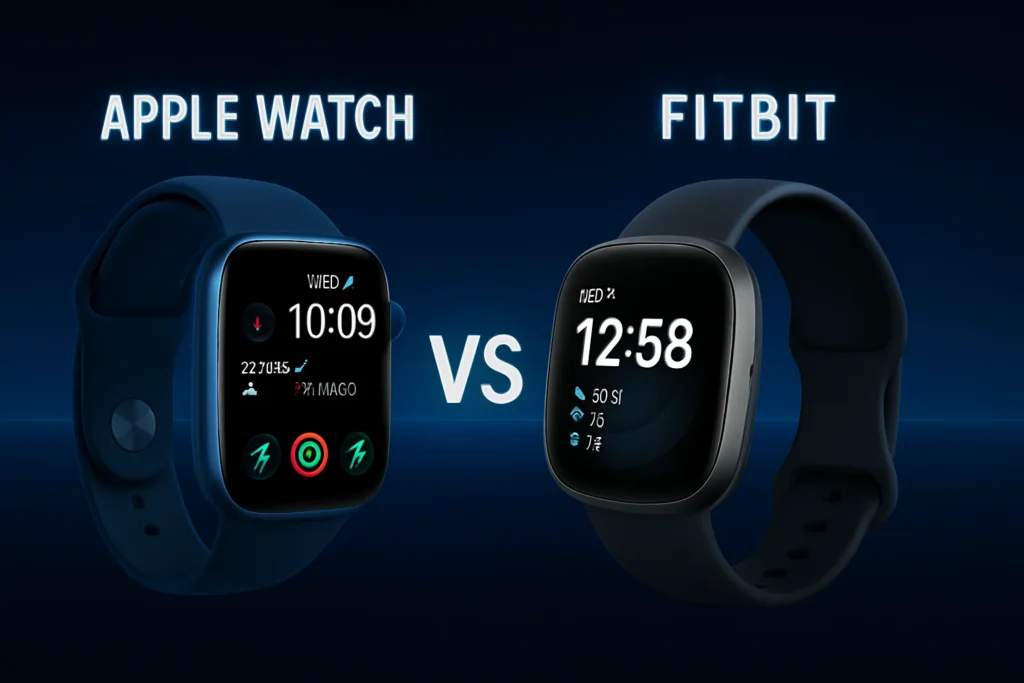Wearable technology has moved far beyond simple step counters. In 2026, devices like the Apple Watch Series 11 and the Fitbit Sense 3/Versa 5 represent the cutting edge of personal health tracking.
Both Apple and Fitbit (now owned by Google) are leading players in the wearable space, but they cater to slightly different audiences. Apple Watch leans toward integrated lifestyle + fitness + medical monitoring, while Fitbit maintains its stronghold as the everyday health and fitness tracker at a more accessible price point.
So, if you’re wondering: Which is better Apple Watch vs Fitbit in 2026? This in-depth comparison breaks it down across features, performance, and value.
Design & Comfort
- Apple Watch (Series 11 / SE 3)
- Sleek, square display with always-on OLED.
- Premium materials: aluminum, stainless steel, titanium.
- Seamless with Apple ecosystem.
- Customizable bands for fashion and function.
- Fitbit (Sense 3 / Versa 5 / Inspire 4)
- Lightweight, rounder design, feels less like a “mini smartphone.”
- Simple touchscreen interface.
- More fitness-oriented aesthetics (less flashy).
- Affordable band replacements.
👉 Verdict: Apple Watch is premium + fashion-forward; Fitbit is lightweight + practical.
Health Tracking Features
- Apple Watch (2026)
- ECG and irregular heart rhythm alerts.
- Blood oxygen monitoring (SpO₂).
- Body temperature tracking (great for sleep and women’s health).
- New: Non-invasive glucose trend monitoring (still under FDA review).
- Fall detection + car crash detection (life-saving features).
- VO₂ Max readings for fitness intensity.
- Fitbit (2026)
- Sleep score + sleep stage tracking (industry-leading).
- Stress management index with EDA sensors.
- Skin temperature variations for recovery.
- Heart rate zones & resting HR trends.
- Daily Readiness Score (personalized fitness recovery metric).
- Basic ECG and SpO₂ (though not as advanced as Apple).
👉 Verdict: Apple dominates medical-grade features. Fitbit still leads in sleep and stress tracking.
Fitness Tracking & Performance
- Apple Watch
- Best for multi-sport athletes (running, swimming, cycling, HIIT).
- Tight integration with Apple Fitness+.
- Advanced GPS accuracy and pace analysis.
- Works seamlessly with iPhone fitness apps.
- Fitbit
- More approachable for beginners.
- Activity goals = steps, calories, distance (simple metrics).
- Focus on daily activity & motivation.
- Great for those who don’t need pro-athlete analytics.
👉 Verdict: Apple = serious athletes + Apple users. Fitbit = casual fitness enthusiasts.
Battery Life
- Apple Watch 2026
- Still ~18–36 hours depending on usage.
- Fast-charging now standard.
- Biggest weakness remains battery life.
- Fitbit 2026
- 5–7 days typical battery life.
- Sleep tracking doesn’t kill the battery.
- No daily charging stress.
👉 Verdict: Fitbit wins hands down for battery endurance.
Smartwatch Features & Ecosystem
- Apple Watch
- Full App Store access.
- Text, calls, emails from your wrist.
- Siri integration.
- Apple Pay (secure and widely supported).
- Syncs perfectly with iPhone + Mac.
- Fitbit
- Limited app ecosystem (weather, Spotify controls, basic notifications).
- Google Wallet + Google Assistant integration (new in 2026).
- Notifications are more limited.
- Works across Android + iOS.
👉 Verdict: Apple is the smarter smartwatch; Fitbit is a fitness-first device.
Price & Value in 2026
- Apple Watch Series 11: Starting around $399-$799 (depending on model).
- Apple Watch SE 3: Budget-friendly at ~$279.
- Fitbit Sense 3: ~$229.
- Fitbit Versa 5: ~$179.
- Fitbit Inspire 4: ~$99.
👉 Verdict: Fitbit is the budget-friendly choice; Apple is the premium lifestyle option.
Who Should Buy Which in 2026?
- Choose Apple Watch if…
- You’re deeply into the Apple ecosystem.
- You want advanced health monitoring.
- You’re an athlete or professional who needs accuracy + apps.
- Price is less of a concern.
- Choose Fitbit if…
- You want long battery life.
- You prioritize sleep and stress tracking.
- You’re budget-conscious.
- You prefer a simple, focused fitness tracker.
The Future of Wearables (Beyond 2026)
Both companies are looking ahead:
- Apple is pushing toward non-invasive glucose + blood pressure monitoring.
- Fitbit (Google) is doubling down on AI-powered health insights and tighter Android ecosystem integration.
The wearable market is shifting toward medical-grade diagnostics and AI-driven personalized health coaching. Both Apple and Fitbit are preparing to play central roles.
Conclusion
The answer depends on your lifestyle:
- Apple Watch (2026) → For power users, iPhone owners, and athletes.
- Fitbit (2026) → For everyday fitness, sleep tracking, and simplicity.
The best wearable isn’t universal, it’s the one that aligns with your health priorities and daily life.

